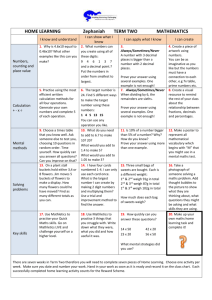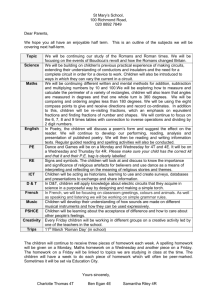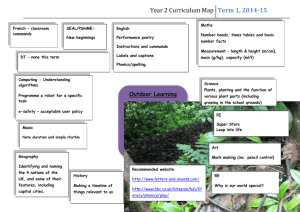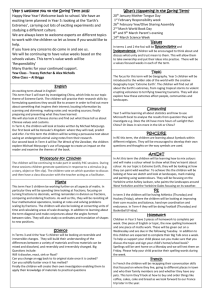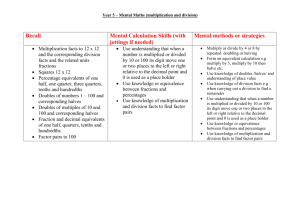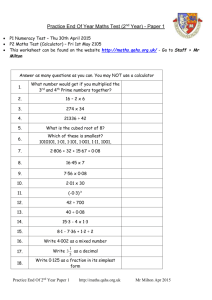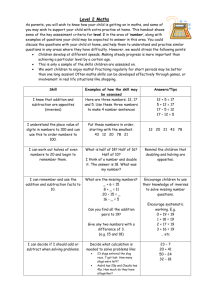Year 4 Maths Makes Sense Planning
advertisement
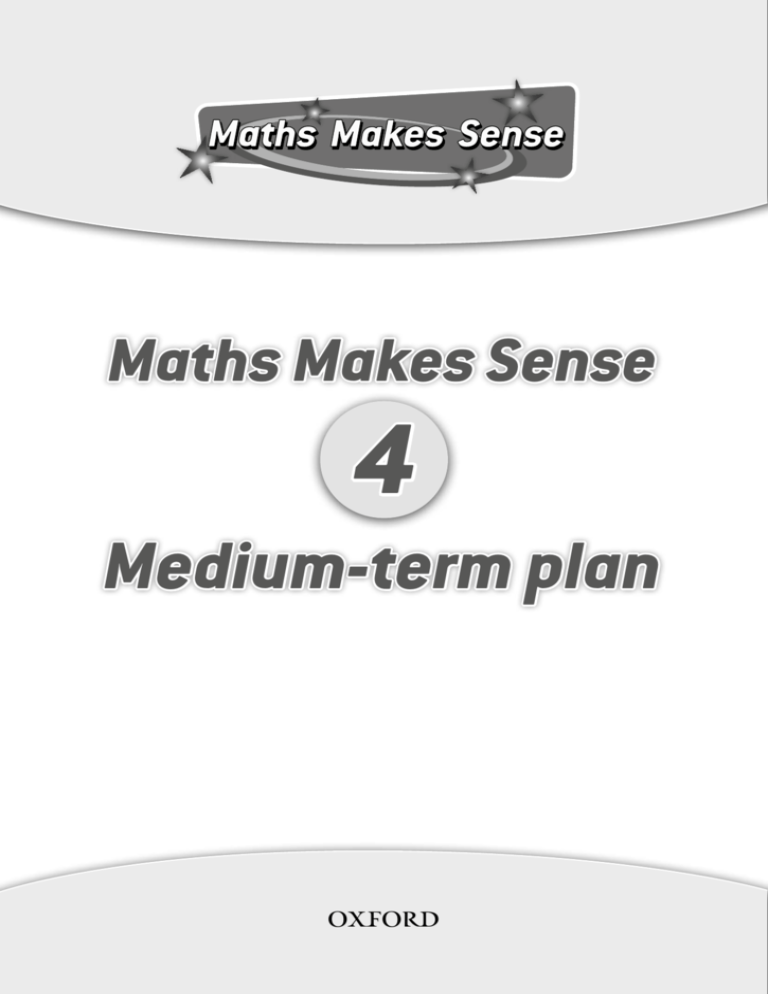
Maths Makes Sense 4 Medium-term plan 2 Maths Makes Sense 4 Block 1 End-of-block objectives Arithmetic 1 Calculate Maths Stories for all four operations with mixed numbers, 1-digit whole numbers, halves and quarters using pupil tables and pupil cups, e.g. 2 _21 – 1 _41 + _ 41 + 3 _41 = 4 _43 Mentally calculate Maths Stories combining addition, subtraction and multiplication with mixed numbers, 1-digit whole numbers, halves and quarters, e.g. _ 21 × 4 − _ 41 × 3 = 1 _41 Mentally calculate Maths Stories for all operations with vulgar fractions (and mixed numbers) and negative numbers, e.g. −2 × 3 + −1 × 4 = −10 Geometry On a pair of axes, draw the image of an object in a vertical, horizontal or oblique mirror line and label the image accurately, e.g. A in the object is labelled A' in the image. Arithmetic 2 Use a grid to multiply a 2-digit whole number by a 2-digit whole number, e.g. 24 × 25 = 600 Calculate answers to one-step word problems using addition, subtraction, multiplication or division, e.g. Nathan had 15 apples. He shared them among five friends. How many apples did each friend get? Reasoning Read and write tens, hundreds, thousands, ten thousands, hundred thousands, millions, ten millions, hundred millions, billions in figures and words, e.g. 100 000 is one hundred thousand Read and write large products of ten as powers of ten, e.g. write 100 000 as 105 Read and write the value of a power of ten, e.g. 105 = 100 000, one hundred thousand. Data and Measure Read metric prefixes, from milli- to kilo-, with any of the basic units of length, mass and volume, and convert between units of measure, e.g. 100 cg = 1 g Use ratio, vulgar fractions and decimal fractions to compare metric units for length, mass and volume, e.g. compare 1 mg : 1 g: smaller, one to one thousand, 1 , .001 1 : 1000, ___ 1000 Read metric equivalences using the decimal point for centi- and milli- and the basic unit for length, e.g. 1 mm = .1 cm. © Oxford University Press 2012 Maths Makes Sense 4 Daily practice Grade 7 Practise adding and subtracting, multiplying and dividing Practise rounding to the nearest 10 and 100 Practise doubling Practise multiplication and division facts up to 100 Practise adding and subtracting 2-digit numbers including pound/pence quantities Convert m to cm, kg to g and ml to Practise same-value swaps Chant times tables Complete a number line with missing negative and positive numbers Say a number that is one more than or one less than any number (negative and positive) on a number line Count the minutes in an hour in fives Find a time half an hour earlier or later than a given digital time Act the Real Story to complete a Maths Story Draw the image of an object in a mirror line Read and write basic metric units and metric prefixes Use a grid to multiply TU × TU Complete addition and subtraction Maths Stories with large numbers and read them in Maths and English Calculate terms to complete a Maths Story that combines multiplication with addition and subtraction Draw images of objects in a mirror line on a pair of axes Read index notation, products of ten and write the correct number of zeros Complete the questions on the ‘I can’ pages in Progress Book 4A Discuss achievements in Progress Book 4A and fill in the chart * * * * * * Resources Cross-curricular links Maths Makes Sense Toolkit Whole cups, half cups, quarter cups, pupil tables, pupil whole cups, pupil half cups, pupil quarter cups, negative number cards (−1, 1, 0), pupil negative number cards, wooden rack, fifths cards, decimetre sticks Science Other Cm-squared and lined exercise books, pupil fifths cards, flipchart with squared paper, calculators, clock, 15-cm rulers, 30-cm rulers, 1-metre ruler, a large hand mirror Data and Measure: use the vocabulary and actions for centimetre and decimetre when measuring length, and kilograms and grams when measuring mass PSHCE Progress Books ‘I can’ pages: practise turn-taking and listening skills when discussing achievements in Progress Books Key vocabulary object • image • A dash (A') • mirror line• milli-, centi-, deci-, deca-, hecto- and kilo- • term • x axis, y axis • power © Oxford University Press 2012 •Overview plan Block Block 1 • 1Medium-term Maths Makes Sense 4 Block 2 End-of-block objectives Arithmetic 1 Read and write decimal fractions to three decimal places, e.g. 0.1, .01, .41, .041, .421 Read and write numbers written in decimal notation (to three places) as vulgar fractions using tenths, hundredths or thousandths as the denomination, e.g. read .1 as one tenth and write it as __ 101 Mentally calculate addition and subtraction combined with multiplication Maths Stories with decimal fractions, e.g. .02 × 3 – .01 × 4 = .02 Mentally calculate division Maths Stories with decimal fractions (not tricky), e.g. .06 ÷ .02 = 3 Mentally calculate each of the four operations, and combinations of addition and subtraction with multiplication, using vulgar fractions, mixed numbers and negative numbers (no tricky examples), e.g. _ 21 × 3 – _ 41 × 2 = 1, 2 _53 – 1 _51 = 1 _52 , – 4 – –2 + –3 = –5. Geometry Arithmetic 2 Use a calculator to solve one-step addition and subtraction word problems involving measures, with 4-digit numbers, e.g. Mira poured 2760 ml of milk into a jug. She then poured 1121 ml into the jug. What was the volume of water in the jug? Use a calculator to solve one-step addition, subtraction, multiplication and division word problems involving measures, including decimals, e.g. Callum buys a comic every week which costs £1.67 and does this for eight weeks. How much does he spend? Reasoning Calculate products of two multiples of ten using a 1-digit multiplication Maths Story, e.g. use 3 × 4 = 12 to calculate 3000 × 400 = 1 200 000 Deduce and write division Maths Stories for products of two multiples of ten, e.g. for 3000 × 400 = 1 200 000, say and write 1 200 000 ÷ 3000 = 400 and 1 200 000 ÷ 400 = 3000. Use a protractor to draw acute angles Say whether a drawn angle is acute, obtuse or reflex. Data and Measure Calculate the area of a rectangle by writing a multiplication basic Real-Life Story, e.g. 3 m2 × 4 = 12 m2 Calculate the volume of a picture combining cuboids by writing a multiplication basic Real-Life Story, e.g. 3 cm3 × 2 × 5 = 30 cm3. © Oxford University Press 2012 Maths Makes Sense 4 Daily practice Grade 8 Practise adding and subtracting, multiplying and dividing Practise rounding to the nearest 10 and 100 Practise giving multiples of 10 Convert between decimal and vulgar fraction equivalents for tenths, Convert analogue into digital time Convert cm into m, ml into , g into kg Give multiples of 5 and 10 up to 100 Giving turns in degrees Convert pence to pounds Chant times tables Practise multiplication and division facts up to 100 Practise adding and subtracting tricky 2-digit numbers including pound/pence quantities Convert analogue into digital time Read the time from an analogue clock, accurately noting the minutes * * * * * * Resources Look at Maths Stories with tenths as decimals and fractions and read what they say and mean Use a protractor to draw acute angles Use the subtraction of areas to solve problems Complete calculations with pounds written as decimals Complete a multiplication Maths Story and say and write new Maths Stories using the product and tens, hundreds and thousands Calculate mentally with tenths, hundredths and thousandths as decimal fractions for addition and subtraction combined with multiplication (not tricky) Draw an acute angle and decide whether a drawn angle is acute, obtuse or reflex Write two new division Maths Stories using the factors shown in a multiplication Maths Story Complete the questions on the ‘I can ‘ pages in Progress Book 4A Discuss achievements in Progress Book 4A and fill in the chart Cross-curricular links Science, History, Geography Maths Makes Sense Toolkit Tenth cards, decimal cards (a tenth, 10 .1, 0.1, .10, 0.10), percentage disc, angle templates, semicircle template, pupil whole cups, pupil half cups, pupil quarter cups, pupil tables __ 1 , Other Pupil number cards, (a fifth, a tenth, __ 101 , .1, 0.1, .10, 0.10, –1), cm-squared, lined and plain exercise books, 15-cm rulers, calculators, protractors, blue and red pens, metre ruler, modelling clay, teaching protractor, geared clock, flipchart Arithmetic 2: use coins from different countries, and historical coins in word problems PSHCE Progress Books ‘I Can’ pages: practise turn-taking and listening skills when discussing achievements in Progress Books Key vocabulary acute • reflex • obtuse• four tenths, point four, SV:DA• outside protractor • inside protractor • product • factor © Oxford University Press 2012 •Overview plan Block Block 2 • 1Medium-term Maths Makes Sense 4 Block 3 End-of-block objectives Arithmetic 1 Arithmetic 2 Mentally calculate Maths Stories using fractions, mixed numbers and negative numbers (no tricky examples), e.g. _ 53 × 2 = 1 _51 , 1 _51 + 3 _52 = 4 _53 and − 4 – −2 + −3 = −5 Group together additions and subtractions to make calculating 3-digit addition and subtraction Maths Stories easier, e.g. 123 + 452 – 231 + 128 – 327 = 123 + 452 + 128 – 231 – 327 = 703 – 558 = 145 Say the value of any indicated digit or combination of digits in a 4-digit whole number and in a 4-digit number to the third decimal place, e.g. the value of the ‘6’ in 3618 is six hundred Solve word problems about measures and everyday objects. Calculate 4-digit whole number vertical additions and subtractions (no tricky columns) Calculate vertical additions and subtractions with decimal fractions (no tricky columns) Use a grid to multiply two 2-digit numbers (TU by TU), e.g. 23 × 21 = 483 Reasoning Mentally calculate the product of three 1-digit numbers and write the answer Copy index notation for powers of ten up to 109 Write the product of tens for index notation up to 109 Use a calculator to calculate and write the product of three numbers, each with a whole number and a decimal fraction. Geometry Use the vocabulary arc, chord, circumference, radius and diameter correctly Follow instructions to use compasses to draw a circle, together with a hexagon and triangle within the circle, e.g. draw a circle with centre C and a radius of 3 cm. Data and Measure Use the formula C = × d to calculate the circumference of a circle. © Oxford University Press 2012 Maths Makes Sense 4 Daily practice Grade 9 Practise adding, subtracting and dividing Give multiples of 3, 4, 5, 6, 7, 9 and 10 Find common equivalent fractions Convert between decimal and vulgar fraction equivalents for tenths, hundredths and thousandths Convert kg to g, pounds into pence, cm to m Find a time three quarters of an hour earlier or later than a digital time Practise adding and subtracting tricky 2-digit numbers including pound/pence quantities Write pound/pence quantities as a decimal number Practise multiplication and division facts up to 100 Chant times tables Say how many minutes has elapsed between one time and another Calculate vertical additions and subtractions to two decimal places Label the chord, arc, diameter and circumference on a diagram of a circle Use a calculator to multiply the diameter of circles by 3.14 to find the circumference Group together additions and subtractions to rearrange a Maths Story and solve a word problem Calculate the product of three numbers including fractions Use a grid to multiply TU × TU Follow instructions to draw a circle and a triangle with compasses Calculate the product of three decimal numbers using a calculator Complete the questions on the ‘I can’ pages in Progress Book 4B Discuss achievements in Progress Book 4B and fill in the chart * * * * * * Resources Cross-curricular links Maths Makes Sense Toolkit Art, Design and Technology Dm sticks, whole cups, pupil tables, pupil cups, pupil half cups, fifth cards, decimal cards (.1, .10, 0.1, 0.10), place value cards Other Lined, cm-squared and plain exercise books, calculators, paper tape, 15-cm rulers, board compasses, compasses, short pencils, cylinders, strips of paper, geared clock, metre rulers Geometry: make models using named 3D shapes Speaking and Listening Daily Practice: practice times tables at different times during the day. PSHCE Progress Books ‘I Can’ pages: practise turn-taking and listening skills when discussing achievements in Progress Books Key vocabulary diameter • circumference • chord • arc • radius • (‘pi’) © Oxford University Press 2012 •Overview plan Block Block 3 • 1Medium-term Maths Makes Sense 4 Block 4 End-of-block objectives Arithmetic 1 Complete vertical additions and subtractions with decimal fractions (any column tricky) Use a grid for long division, dividing a 2-digit or 3-digit number by a 1-digit number (TU ÷ U or HTU ÷ U), using both remainders and fractions. Arithmetic 2 Solve word problems using the sum of two products, e.g. Lila had three boxes with 22 pencils in each box, and two boxes with 31 pencils in each box. How many pencils did she have altogether? Solve word problems involving decimal quantities, e.g. Three friends won £12.48 in a competition. They all got an equal share. How much did they each get? Geometry Draw a pair of axes and label them with positive and negative numbers Follow instructions to draw circles and polygons on a pair of axes (four quadrants) Reasoning Calculate a product of two numbers, each a decimal fraction up to two decimal places, e.g. .2 × .04 = .008. Name lines of symmetry. Data and Measure Calculate the mean of a sample of piles of cups by dividing the total number of cups by the number of piles. © Oxford University Press 2012 Maths Makes Sense 4 Daily practice Grade 10 Practise adding, subtracting, multiplying and dividing Give multiples of 8, 9 and 10 and factors of 4, 10, 12 and 15 Find common equivalent fractions Find decimal and vulgar fraction equivalents in tenths, hundredths and thousandths Convert g to kg, mm to m, cm to m, ml to and pence to pounds Estimate the size of an angle in degrees Practise subtracting including pence quantities Practise adding and subtracting tricky 2-digit numbers including pounds/pence quantities Practise multiplication and division facts up to 100 Name triangles Chant times tables Say how many minutes have passed between two times * * * * * * Write addition and subtraction Maths Stories with two decimal places vertically to calculate the answer Look at statistics and indicate whether they are descriptive statistics or summary statistics Draw and label coordinates on a pair of axes Use a calculator to complete Maths Stories with two multiplication terms and to complete two division decimal Maths Stories, rounding to two decimal places Calculate the product of two fractions each with a denominator in tenths, hundredths and thousandths Calculate HTU ÷ U using a grid Follow instructions to draw a circle on a pair of axes and plot coordinates to construct a quadrilateral Look at a decimal fraction multiplication and say and write the value of each digit up to three decimal places as vulgar fractions Complete the questions on the ‘I can’ pages in Progress Book 4B Discuss achievements in Progress Book 4B and fill in the chart Resources Cross-curricular links Maths Makes Sense Toolkit Art, Geography _ 1 cards, 5 Whole cups, percentage disc pupil cups, Other Geometry: plot coordinates, make pictures using shapes in four quadrants ICT Metre ruler, 15-cm rulers, square flipchart, cm-squared and lined exercise books, calculators, board compasses, compasses, short pencils Data and Measure: use ICT to present summary and descriptive statistics Outdoor play/physical education Daily practice: record time at beginning and end of activity and say how many minutes have passed between two times Key vocabulary descriptive statistics • summary statistics • mean• coordinates © Oxford University Press 2012 Block 4 • Medium-term plan Maths Makes Sense 4 Block 5 End-of-block objectives Arithmetic 1 Mentally calculate whole number percentages of a whole number quantity (no tricky examples), e.g. 4% of 800 = 32 For a decimal number percentage of a whole number quantity, use a calculator to complete the calculation, e.g. 5.3% of 400 = 21.2 Round a decimal fraction using tenths or tenths and hundredths to the nearest whole number, e.g. 15.2 15. Geometry Use compasses and a ruler to draw triangles with given lengths of sides, e.g. Draw triangle ABC, AB = 5 cm, BC = 5 cm, CA = 5 cm. Arithmetic 2 Solve word problems involving percentages of quantities, e.g. There are 600 children in a school. 5% of the children bring sandwiches for lunch. How many children is that? Solve word problems involving percentages of quantities using a calculator but without using the percentage key, e.g. The price of a £600 television is decreased by 8.3%. How much money is saved? Reasoning Identify and calculate the value of each term in an expression, use the values to add and subtract from left to right, and complete the Maths Story. Data and Measure Calculate equivalent fractions by drawing ratio sticks Calculate fractions of quantities and recognise that using an equivalent fraction gives the same answer. © Oxford University Press 2012 Maths Makes Sense 4 Daily practice Grade 11 Practise adding, subtracting, multiplying and dividing Give multiples of 1, 5, 7, 9 and factors of 12, 15, 16 and 18 Convert decimals to fractions using a calculator Find common equivalent fractions Find decimal and vulgar fraction equivalents for tenths, hundredths and thousandths Convert mm to cm, minutes to seconds and an hour to seconds Estimate an angle in degrees Practise adding and subtracting tricky 2-digit numbers including pound/pence quantities Practise multiplication and division facts up to 100 Name quadrilaterals Chant times tables Say how many minutes have passed between two times Calculate mentally whole number percentages of multiples of 100 Copy a triangle accurately using compasses Calculate equivalent fractions Write and calculate a multiplication Maths Story to solve a percentage word problem Identify multiplication terms and work from left to right to complete addition and subtraction Maths Stories Use a calculator to check percentages and round the answer to the nearest whole number Draw line segments and use compasses to draw a triangle Calculate the value of multiplication terms with decimal fractions with a calculator to complete addition and subtraction Maths Stories Complete the questions on the ‘I can’ pages in Progress Book 4C Discuss achievements in Progress Book 4C and fill in the chart * * * * * * Resources Cross-curricular links Maths Makes Sense Toolkit Literacy Ratio sticks, whole cups, pupil whole cups, pupil tables Other Lined exercise books, cm-squared exercise books, plain exercise books, calculators, compasses, short pencils, 15-cm rulers, metre ruler, board compasses, set squares, real clock Arithmetic: challenge children to think of imaginative Real-Life Stories with percentage increase and decreases Art, Geography Geometry: use special triangles to make collages of the school and grounds PSHCE Play ‘getting to know you’ games with designated partners, practising active listening and turn-taking skills Key vocabulary per cent • equivalent fractions • expression • approximately equal to © Oxford University Press 2012 Block 5 • Medium-term plan Maths Makes Sense 4 Block 6 End-of-block objectives Arithmetic 1 Use ‘one add negative one equals zero’ (1 + −1 = 0) with tricky addition and subtraction, e.g. 3 + −2 = 1 and 4 − −2 = 6 Use a grid to multiply two 2-digit whole numbers (TU × TU), e.g. 45 × 23 = 1035 Use a grid for long division, dividing a 3-digit whole number by a 1-digit whole number (HTU ÷ U) using both remainders and fractions, e.g. 727 ÷ 6 = 121 _61 . Geometry Use a protractor to measure acute and obtuse angles in degrees Use the inside and outside protractors to draw specified acute and obtuse angles with centre of rotation C. Data and Measure Arithmetic 2 Solve word problems using the four operations, fractions of quantities, percentages of quantities and the sum of two products, e.g. _ 43 of 12 metres, 5.3% of 640, 3 × 23 + 2 × 35 Use the symbol for ‘approximately equal to’ (nearly equal to) Round an answer with two decimal places to the nearest one decimal place, e.g. 33.92 33.9. Reasoning For algebraic expressions using the symbols x and y, add and subtract terms, working from left to right, to write an expression with Same Value: Different Appearance, e.g. 5y + 2x − 3y has the Same Value: Different Appearance as 2y + 2x. Use ratio to convert between pounds and euros, miles and km, and vice versa, with quantities to two decimal places Use ratio to convert between seconds, minutes and hours. © Oxford University Press 2012 Maths Makes Sense 4 Daily practice Grade 12 Practise adding, subtracting, multiplying and dividing Give multiples of 5, 7, 8 and 10 and factors of 10, 15, 18, 20, 24 and 25 Find common equivalent fractions Find decimal and vulgar fraction equivalents for tenths, hundredths and thousandths Convert fractions to decimals with a calculator Total fractions to 1 Round to the nearest 10 or 100 Convert cm to m, g to kg and to ml Describe an acute, obtuse or reflex angle Find an earlier or later time than a given digital time Practise adding and subtracting tricky 2-digit numbers including pound/pence quantities Practise multiplication and division facts up to 100 Resources Name triangles and quadrilaterals Chant times tables * * * * * * Use ‘negative one and one’ same-value swaps with zero for tricky addition and subtraction Use a protractor to measure angles Convert miles to km and km to miles Solve word problems and calculate fractions of quantities using ratio Act the Real Story and complete the Maths Story using x and y in the same algebraic expression Use a grid for TU × TU Draw a triangle accurately using compasses and measure the interior angles Write the expression with the Same Value: Different Appearance for calculations that use x and y Complete the questions on the ‘I can’ pages in Progress Book 4C Discuss achievements in Progress Book 4C and fill in the chart Cross-curricular links Science, History, Geography Maths Makes Sense Toolkit − Negative number cards ( 1, 1, 0), wooden stand, pupil tables, x cards, y cards, whole cups Other Arithmetic: practise calculating with negative numbers using temperature, timelines, time zones Outdoor work Lined, cm-squared and plain exercise books, pupil negative number cards (−1, 1, 0), protractors, 15-cm rulers, board protractor, metre ruler, calculators, clock with moveable hands including a second hand, 12 pens, pupil x cards, pupil y cards Data and Measure: use distance covered either during school trip or outdoor activity and convert between miles and kilometres ICT Data and Measure: use ICT to present information regarding currency exchange rates Key vocabulary algebra • algebraic expression • obtuse © Oxford University Press 2012 Block 6 • Medium-term plan

